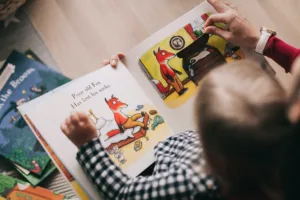Reading plays a significant role in the development of children, fostering their imagination, expanding their knowledge, and shaping their values. Moral stories, in particular, have a profound impact on young minds by teaching important life lessons and values in an engaging and relatable manner. In this article, we will explore ten of the best books of moral stories for kids. These books not only entertain but also inspire children to embrace virtues, make wise choices, and navigate the complexities of life. Each book offers unique storytelling and valuable lessons that can leave a lasting impression on young readers.
“Panchatantra” by Vishnu Sharma:
Panchatantra is a timeless collection of animal fables that imparts wisdom and moral teachings through captivating narratives. The stories in Panchatantra teach children about the consequences of their actions, the importance of loyalty, and the power of wit and intelligence.

Jataka Tales” by Ellen C. Babbit:
Jataka Tales presents a collection of stories from the previous lives of Gautama Buddha. These tales teach children about compassion, kindness, and moral principles such as honesty, generosity, and selflessness. Through animal characters and relatable situations, the Jataka Tales inspire children to cultivate virtues in their own lives.
“Aesop’s Fables” by Aesop:
Aesop’s Fables is a renowned collection of moral stories that have been cherished for centuries. Each fable features animals as characters and imparts important life lessons such as honesty, hard work, and the consequences of greed. These short, simple stories are easy for children to grasp and understand.

“Akbar and Birbal Stories” by Amita Sarin:
The tales of Akbar and Birbal revolve around the witty exchanges and problem-solving skills of Emperor Akbar and his clever advisor, Birbal. These stories not only entertain children but also teach them valuable lessons in wit, intelligence, and critical thinking.
“Where the Wild Things Are” by Maurice Sendak:
“Where the Wild Things Are” is a beloved children’s book that takes readers on a wild and imaginative journey. The story follows a young boy named Max who, after being sent to his room for misbehaving, embarks on a fantastical adventure to a land of wild creatures. Through his encounters with the “wild things,” Max learns the importance of self-expression, understanding, and the power of his own imagination. This beautifully illustrated book sparks creativity and encourages children to embrace their inner wildness and explore the wonders of their imagination.

Charlotte’s Web” by E.B. White: This enchanting story revolves around the friendship between a spider named Charlotte and a pig named Wilbur. As they navigate the challenges of life on a farm, Charlotte uses her web-spinning abilities to save Wilbur from being eaten. The book beautifully illustrates the power of friendship, empathy, and the impact of small acts of kindness. It encourages children to appreciate the beauty of nature and the value of true friendship.

The Magic Seed: A Journey of Kindness and Generosity” by Rina Singh is a heartwarming children’s book that tells the story of a young girl named Maya who discovers a magical seed. With each act of kindness she performs, the seed grows and transforms into something beautiful. Through this enchanting tale, children learn about the power of kindness, generosity, and the positive impact their actions can have on others. The book’s vibrant illustrations and engaging storyline make it a captivating read for young readers, teaching them valuable lessons about empathy, compassion, and the importance of making a difference in the world.
![]()
“The Very Hungry Caterpillar” by Eric Carle:
“The Very Hungry Caterpillar” is a beloved children’s book that follows the journey of a caterpillar as it eats its way through various foods before transforming into a beautiful butterfly. Through vibrant illustrations and simple text, the book teaches children about the life cycle of a butterfly, counting, days of the week, and healthy eating. It encourages children to explore nature, appreciate the wonders of the world, and learn important concepts in an engaging and interactive way.

The Giving Tree” by Shel Silverstein: The Giving Tree” is a heartwarming tale of selfless love and friendship. The book tells the story of a tree and a young boy who develop a deep bond as the boy grows up. The tree gives everything it has to make the boy happy, even if it means sacrificing its own well-being. This beautiful story teaches children about the importance of kindness, generosity, and appreciating the love and support of others.

“Oh, the Places You’ll Go!” by Dr. Seuss is a beloved children’s book that takes readers on an exciting journey through life’s ups and downs. With its whimsical illustrations and playful rhymes, the book inspires children to embrace adventure, overcome challenges, and believe in their own potential. It teaches valuable lessons about resilience, perseverance, and the importance of staying true to oneself. Dr. Seuss’s timeless storytelling and imaginative characters make this book a classic that continues to captivate and inspire generations of young readers.

In conclusion, Books of moral stories play a vital role in shaping the character and values of young readers. The ten books mentioned above offer a rich tapestry of storytelling, wisdom, and moral teachings for kids. By reading these books, children not only enhance their reading skills but also imbibe important life lessons such as honesty, kindness, perseverance, and critical thinking. As parents and educators, it is essential to introduce children to these books and encourage the habit of reading moral stories, enabling them to grow into responsible, compassionate, and principled individuals.
————————————————————————-
Preventing Cell Phone Addiction in Kids: Effective Methods and Techniques.












